
The chemistry of isatins a review from 1975 to 1999
.pdfPlease use CPS: orgchem/0010004 in any reference to this article
1
The chemistry of isatins: a review from 1975 to 1999
Joaquim Fernando M. da Silva,* Simon J. Garden and Angelo da C. Pinto
Departamento de Química Orgânica, Instituto de Química,
Universidade Federal do Rio de Janeiro, RJ, 21945-970, Brazil
Isatina (1H-indol-2,3-diona) é um composto de grande versatilidade sintética, podendo ser utilizado na obtenção de diversos sistemas heterocíclicos, como derivados indólicos e quinolínicos, o que a torna uma importante matéria-prima na síntese de fármacos. Isatina também tem sido detectada em tecidos de mamíferos, o que tem despertado o interesse em seu estudo como modulador em diversos processos bioquímicos. Os avanços na aplicação de isatinas em síntese orgânica, bem como na compreensão de seus efeitos biológicos e farmacológicos, nos últimos vinte e cinco anos encontram-se relatados nesta revisão e seus respectivos materiais suplementares.
Isatin (1H-indole-2,3-dione) is a synthetically versatile substrate, where it can be used for the synthesis of a large variety of heterocyclic compounds, such as indoles and quinolines, and as a raw material for drug synthesis. Isatin has also been found in mammalian tissues, and its function as a modulator of biochemical processes has been the subject of several discussions. The advances in the use of isatin for organic synthesis during the last twenty-five years, as well as a survey of its biological and pharmacological properties are reported in this review and in the accompanying supplementary information.
Keywords: isatin, heterocyclic synthesis, drug synthesis, metal complexes
1. Introduction
This article is available from: http://preprint.chemweb.com/orgchem/0010004 Uploaded 17 October 2000 at 14:44 GMT

Please use CPS: orgchem/0010004 in any reference to this article
2
Isatin (1H-indole-2,3-dione, Figure 1) was first obtained by Erdman and Laurent in 1841 as a product from the oxidation of indigo by nitric and chromic acids.
O
5 4 3
2 O
6 |
|
N1 |
|
|
|
|
7 |
H |
|
|
Figure 1
The synthetic versatility of isatin has led to the extensive use of this compound in organic synthesis. Three reviews have been published regarding the chemistry of this compound: the first by Sumpter, in 19541, a second by Popp in 19752, and the third on the utility of isatin as a precursor for the synthesis of other heterocyclic compounds3. The synthetic versatility of isatin has stemmed from the interest in the biological and pharmacological properties of its derivatives. These properties are more fully detailed in the supplementary material.
In nature, isatin is found in plants of the genus Isatis4, in Calanthe discolor LINDL.5 and in Couroupita guianensis Aubl.6, and has also been foundas a component of the secretion from the parotid gland of Bufo frogs7, and in humans as it is a metabolic derivative of adrenaline8-10. Substituted isatins are also found in plants, for example the melosatin alkaloids (methoxy phenylpentyl isatins) obtained from the Caribbean tumorigenic plant Melochia tomentosa11-13 as well as from fungi: 6-(3’-methylbuten-2’-yl)isatin was isolated from
Streptomyces albus14 and 5-(3’-methylbuten-2’-yl)isatin from Chaetomium globosum15. Isatin has also been found to be a component of coal tar16.
This review aims to document the publications concerning isatin, its synthesis, chemical reactivity and pharmacological properties during the period from 1975 to 1999. The biological and pharmacological data obtained from the scientific literature are summarized in
This article is available from: http://preprint.chemweb.com/orgchem/0010004 Uploaded 17 October 2000 at 14:44 GMT
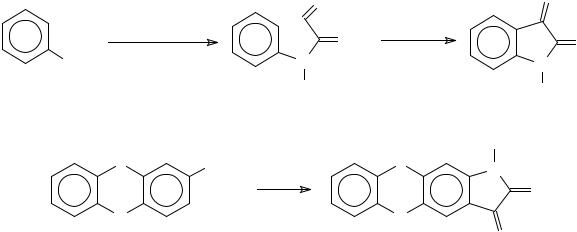
Please use CPS: orgchem/0010004 in any reference to this article
3
Supplementary Material 1. A graphical survey of the application of isatin in the synthesis of other heterocyclic systems is presented in Supplementary Material 2 and Supplementary Material 3 is a summary of metal complexes and some organometallic derivatives of isatin. These supplementary materials are available at www.sbq.org.br. The databases used for the preparation of this review were Chemical Abstracts, MEDLINE (www.healthgate.com), Beilstein (chemweb.com), Web of Science ISIS (webofscience.fapesp.br) and the IBM intellectual property network (www.patents.ibm.com).
2. Synthesis of isatins
2.1 The Sandmeyer methodology
The method developed by Sandmeyer is the oldest and the most frequently used for the synthesis of isatin. It consists in the reaction of aniline with chloral hydrate and hydroxylamine hydrochloride in aqueous sodium sulfate to form an isonitrosoacetanilide, which after isolation, when treated with concentrated sulfuric acid, furnishes isatin in >75% overall yield17. The method applies well to anilines with electron-withdrawing substituents, such as 2-fluoroaniline18, and to some heterocyclic amines, such as 2-aminophenoxathine19
(Scheme 1).
|
|
NOH |
Cl3CCH(OH)2 |
O |
|
NH2OH.HCl |
N |
|
NH2 Na SO |
4 |
|
2 |
|
|
H
S NH2
O
|
O |
|
1) H2SO4 |
O |
|
2) H2O |
||
N |
||
|
H
H
S N
O
O
O
This article is available from: http://preprint.chemweb.com/orgchem/0010004 Uploaded 17 October 2000 at 14:44 GMT
Please use CPS: orgchem/0010004 in any reference to this article
4
Scheme 1
This method has some economic advantages, as the reagents are cheap and readily available, and the yields are usually high. Recently, the Sandmeyer methodology has been modified by the incorporation of ethanol as a co-solvent20. This modification proved to be particularly useful in cases where the aniline derivative was insoluble in the conventional reaction matrix. Application of the modified Sandmeyer methodology allowed the synthesis of 4,6-dibromoisatin, a key intermediate for the synthesis of the marine natural product convolutamydine A, in 85% yield, thus representing a greater than 700% improvement in yield over the existing published procedure. The use of microwave irradiation during both stages of the Sandmeyer procedure has been investigated, and this modified procedure was also employed for the synthesis of convolutamydine A21.
In addition to the use of H2SO4 for the cyclization step, isonitrosoacetanilides can be heated in BF3.Et2O at 90 oC. After cooling the reaction mixture, addition of water allows isolation of the respective isatins. This methodology has proved to be particularly effective for the preparation of benzo-oxygenated isatin derivatives22,23
The Sandmeyer synthesis has been described as being unapplicable to ortho-hydroxy or ortho-alkoxyanilines. Therefore an alternative procedure for the synthesis of the isonitrosoacetanilides was reported24,25 (Scheme 2).
This article is available from: http://preprint.chemweb.com/orgchem/0010004 Uploaded 17 October 2000 at 14:44 GMT
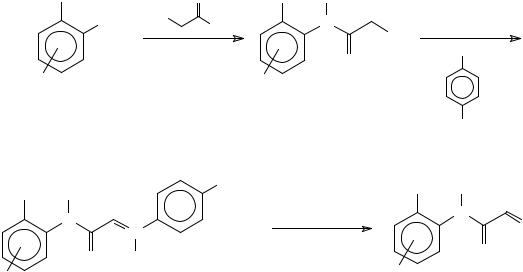
Please use CPS: orgchem/0010004 in any reference to this article
5
OMe |
O |
NH2 |
Cl |
Cl |
OMe H
N |
Cl |
1. Pyridine |
|
|
|
NMe2 |
|
O |
|
2. |
|
|
|
||
R R
NO
OMe H |
|
NMe2 |
OMe H |
|
|
1. H O+ |
N |
||
N |
|
|||
N |
3 |
NOH |
||
|
2. H2NOH |
|||
|
O |
|||
O |
O |
|||
|
R |
|||
R |
|
|
||
|
|
|
Scheme 2
On the other hand, there are some disadvantages, for instance those listed below.
a)The use of N-alkylanilines furnishes the corresponding N-alkylisatins in low yield. For example, N-methylisatin is obtained in 22% overall yield26.
b)Meta-substituted anilines lead to two isomers (4-and 6-substituted isatins), e.g., 3-bromo-4- methoxyaniline yields 4-bromo-5-methoxyisatin (27%) e 6-bromo-5-methoxyisatin (63%). These isomers can be separated by conversion to the corresponding sodium isatinates using 0.5N NaOH. Subsequent controlled acidification of the reaction medium leads to cyclisation of the two isomers at different pH values, regenerating the corresponding isatins, which precipitate from the reaction medium27 (Scheme 3).
This article is available from: http://preprint.chemweb.com/orgchem/0010004 Uploaded 17 October 2000 at 14:44 GMT
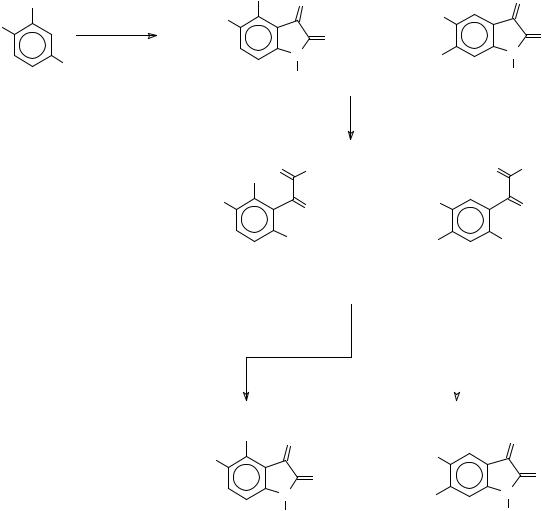
Please use CPS: orgchem/0010004 in any reference to this article
6
Br |
Br |
O |
|
MeO |
O |
MeO |
MeO |
|
|
O |
|
|
O |
+ |
|||
|
|
||||
|
NH2 |
N |
|
Br |
N |
|
H |
|
|
H |
|
|
|
|
|
||
|
|
|
|
NaOH 0,5N |
|
|
Br O |
- |
+ |
|
O O-Na+ |
|
O Na |
|
|
|
|
|
MeO |
O |
+ |
MeO |
O |
|
|
|
|||
|
|
NH2 |
|
Br |
NH |
|
|
|
|
|
2 |
|
|
|
4,5 < pH < 8,0 |
pH < 4,0 |
|
|
|
|
Br O |
MeO |
O |
MeO |
O |
|
O |
|
|
N |
Br |
N |
H |
|
H |
Scheme 3
c) The formation of HCN during the reaction has been detected by the formation of Prussian blue on addition of ferrous sulfate and NaOH28. The measured concentration of HCN in the mother liquors from the preparation of the isonitrosoacetanilides was found to be 100 to 200 ppm29. The mechanism informally proposed for the formation of HCN is described below (Scheme 4).
This article is available from: http://preprint.chemweb.com/orgchem/0010004 Uploaded 17 October 2000 at 14:44 GMT
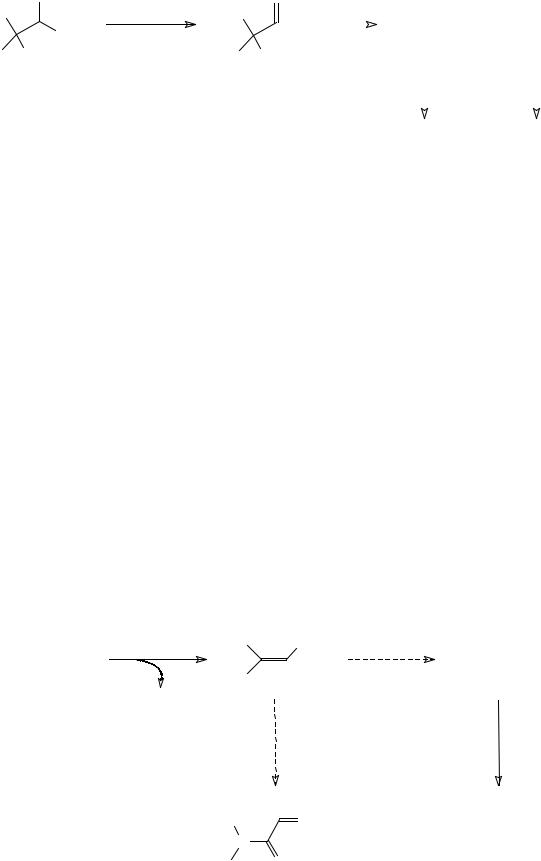
Please use CPS: orgchem/0010004 in any reference to this article
7
OH
Cl |
H2NOH |
OH |
- 2 H2O |
Cl Cl |
|
Cl |
NOH |
|
|
|
|||
- |
+ |
+ |
|
||||
Cl |
|
|
Cl3C |
HC=NOH |
|||
|
|
||||||
Cl |
|
|
|
||||
|
|
|
|
H |
O+ |
|
- |
|
|
|
|
3 |
|
|
HO |
|
|
|
|
|
|
|
|
|
|
|
Cl3CH |
|
HCN + H2O2 |
||
|
Scheme 4 |
|
|
|
|||
An alternative explanation for the formation of HCN can be arrived at by consideration of the mechanism of formation of the intermediate isonitrosoacetanilides. It has been previously postulated, although never unambiguously demonstrated, that an intermediate dichloronitrosoalkene is initially formed by elimination of HCl from clhoraloxime during the Sandmeyer isonitrosoacetanilide synthesis. This nitrosoalkene is subsequently attacked by the aniline to give an addition product that yieldS the isonitrosoacetanilide via a subsequent hydrolysis reaction30,31. However, competitive addition of water and aniline to the nitrosoalkene would lead to formation of the glyoxalic acid oxime and the isonitrosoacetanilide respectively. Under the conditions of the reaction, refluxing aqueous Na2SO4, it could be expected that the glyoxalic acid oxime would decarboxylatively decompose with the concomitant formation of water and HCN (Scheme 5).
Na2SO4 |
Cl |
NO |
H O |
|
Cl3CCHNOH |
|
|
2 |
HO2CCHNOH |
Cl |
|
|
||
|
|
|
|
NaCl
NaHSO4
ArNH2
H NOH
N |
CO2, H2O, HCN |
Ar O
This article is available from: http://preprint.chemweb.com/orgchem/0010004 Uploaded 17 October 2000 at 14:44 GMT
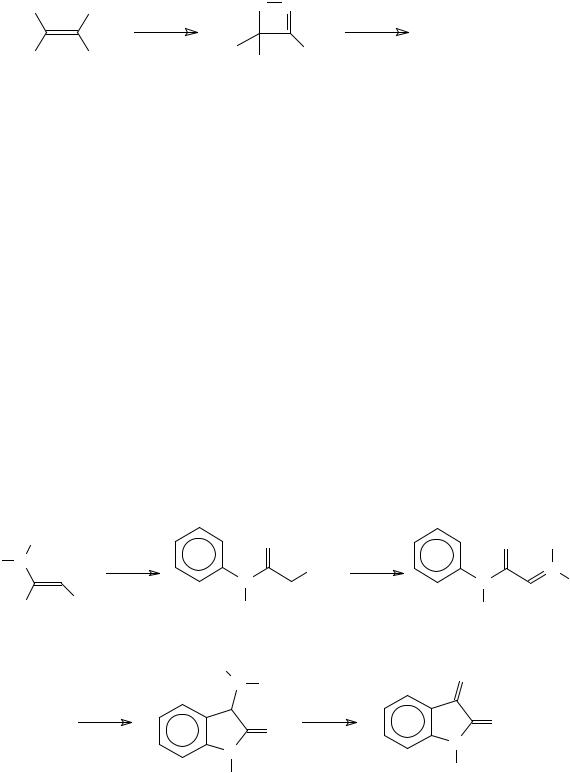
Please use CPS: orgchem/0010004 in any reference to this article
8
Scheme 5
A futher possibility exists. It has been shown that nitrosoalkenes decompose, with formation of HCN, via the formation of an oxazete and retro-cyclisation31 (Scheme 6).
Cl |
NO |
O |
N |
|
|
Cl Cl |
COCl2 + RCN |
Cl |
R |
R |
Scheme 6
Whatever the mechanism for formation of HCN during the Sandmeyer isonitrosoacetanilide synthesis, it is resasonable to recommend that appropriate precautions be taken during the preparation of these compounds.
2.2 Use of nitroacetanilides
Nitroacetanilides, obtained by alkaline hydrolysis of 1-arylamino-1-methylthio-2- nitroethenes, are readily cyclised to isatin-3-oximes by the use of concentrated sulfuric acid or trifluoromethanesulfonic acid at room temperature; the latter giving somewhat higher yields32. Although this methodology is related to the Sandmeyer methodology, it has no obvious benefit over the latter (Scheme 7).
Φ N |
H |
|
O |
|
O |
OH |
|
N |
NO2 |
HA |
N |
||
|
NO2 |
|
|
N |
OH |
|
MeS |
H |
|
|
H |
|
|
|
|
HO |
|
|
NOH |
|
|
|
N |
OH |
|
|
|
|
|
|
|
|
||
|
HA |
|
-H |
O |
|
|
|
|
2 |
|
O |
|
|
|
|
|
O |
|
|
|
N N
H H
This article is available from: http://preprint.chemweb.com/orgchem/0010004 Uploaded 17 October 2000 at 14:44 GMT
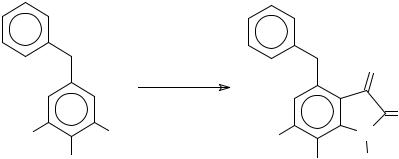
Please use CPS: orgchem/0010004 in any reference to this article
9
Scheme 7
2.3 The Stolle procedure
The most important alternative to Sandmeyer’s procedure is the method of Stolle. In this method anilines are reacted with oxalyl chloride to form an intermediate chlorooxalylanilide which can be cyclized in the presence of a Lewis acid, usually aluminum chloride or BF3.Et2O33, although TiCl434 has also been used to give the corresponding isatin. This method has been used for the synthesis of 1-aryl35,36 and polycyclic isatins derived from phenoxazine, phenothiazine and dibenzoazepine37 as well as indoline38. In the case of dimethoxyanilines, spontaneous cyclization to yield dimethoxyisatins in the absence of a Lewis acid has been observed, as exemplified in the synthesis of melosatin A12, albeit in very low yield (Scheme 8).
|
|
(COCl)2 |
O |
|
|
|
|
|
|
|
O |
MeO |
NH2 |
MeO |
N |
|
OMe |
|
OMe H |
|
|
|
Melosatin A |
Scheme 8
Methoxyisatins can be converted to the corresponding phenolic compounds by the action of pyridinium hydrobromide perbromide. This seems to be the best method for obtaining these derivatives, as aminophenols are not useful substrates for the synthesis of
isatins39.
2.4 The Martinet isatin synthesis
This article is available from: http://preprint.chemweb.com/orgchem/0010004 Uploaded 17 October 2000 at 14:44 GMT
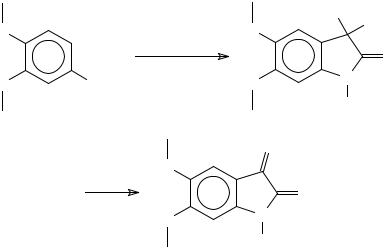
Please use CPS: orgchem/0010004 in any reference to this article
10
The Martinet procedure for the synthesis of indole-2,3-diones involves the reaction of an aminoaromatic compound and either an oxomalonate ester or its hydrate in the presence of an acid to yield a 3-(3-hydroxy-2-oxindole)carboxylic acid derivative which after oxidative decarboxylation yields the respective isatin. This method was applied with success for the synthesis of 5,6-dimethoxyisatin from 4-aminoveratrole whereas the use of 2,4- dimethoxyaniline was less successful40 (Scheme 9).
O |
|
O |
HO |
CO2R |
|
|
|||
|
|
|
|
O |
O |
NH2 |
O |
|
N |
|
|
|
|
H |
O
O
O
ON H
Scheme 9
The Martinet procedure is readily applied to napthylamines, thus yielding benzoisatin
derivatives41.
2.5 The Gassman procedure
A fundamentally different and general procedure developed by Gassman is another option for the synthesis of isatins42,43. This methodology consists in the formation and subsequent oxidation of an intermediate 3-methylthio-2-oxindole44-46 to give the corresponding substituted isatins in 40-81% yield.
Two complementary methods for the synthesis of the 3-methylthio-2-oxindoles were developed, and the methodology of choice is dependent upon the eletronic effect of substituents bonded to the aromatic ring. When electron withdrawing groups are present, the
This article is available from: http://preprint.chemweb.com/orgchem/0010004 Uploaded 17 October 2000 at 14:44 GMT
